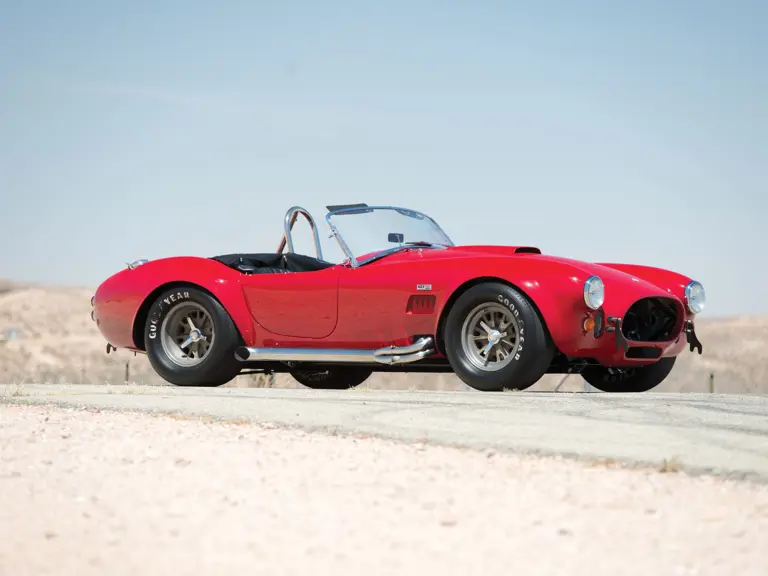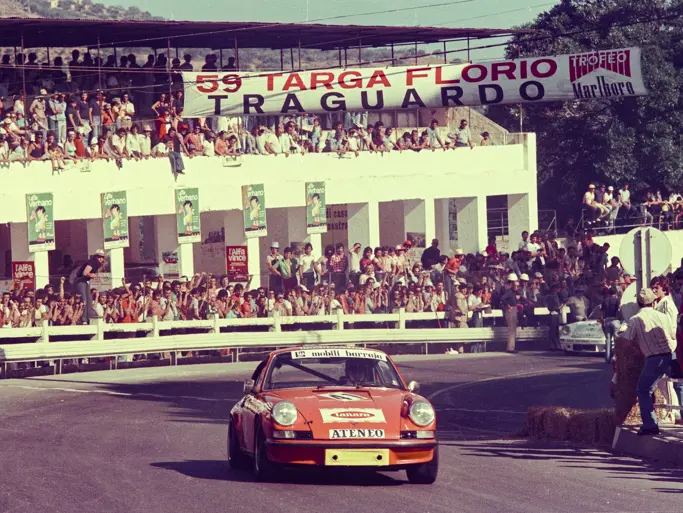The odyssey of the Shelby Cobra is defined by the contributions of many people, marked by many important cars, and by even more important moments. They weave a rich fabric of creativity, determination, and persistence in the face of limited resources and epic challenges.
With Shelby’s leadership, the era’s top drivers, and a “dream team,” including Ken Miles, Phil Remington, Pete Brock, and many other racing luminaries in the background, the Ford-powered, AC Ace-derived Cobra was brutally quick and stone reliable, winning virtually everywhere it appeared. The Cobra won the U.S. Manufacturer’s Championship three years running, in 1963, 1964 and 1965, and with assistance from the sleek Pete Brock-designed Daytona coupe bodywork, Shelby American, Inc. won the hotly contested 1965 FIA World Manufacturer’s Championship.
Although the 289 Cobra was proven and immensely successful, more power was needed to stay competitive. Since Ford’s 289-cid V-8 reached its reliability limit at 385 horsepower, Shelby’s stalwart driver and engineer, Ken Miles, surmised that an even bigger engine might work within the trim confines of the Cobra. If there was any doubt about the need, it evaporated when the Shelby team went to Nassau for the 1963 Speed Week, where Chevrolet’s new Corvette Grand Sports were lapping more than nine seconds quicker than the small-block Cobras!
However, while Shelby was initially promised a new aluminum-block version of Ford’s 390 FE engine, internal resistance from the NASCAR faction within Ford forced a switch to the heavier cast-iron 427. Although powerful, proven, and reliable at 500 brake horsepower and beyond, it was heavier and therefore necessitated a complete redesign of the Cobra’s chassis to ensure proper handling. The new chassis measured five inches wider, with coil springs all around, and with development help from Ford’s engineering department, the 427 Cobra was born.
The cars were fiercely quick. Driving one continues to be a mind-bending experience. One of the most memorable stories about the 427 Cobra involves a test arranged for Sports Car Graphic magazine by Shelby’s Ken Miles. A few years earlier, Aston Martin claimed that their DB4 was capable of accelerating from 0- to 100-mph and back down to zero in less than 30 seconds. Miles had the idea to restage the test using the new 427 Cobra. The result, according to SCG Editor Jerry Titus, was an astounding 13.2 seconds!
Shelby’s big-block cars were never mass-produced, with just over 300 built, including 260 street cars, 23 full-competition cars, and 27 S/C (semi-competition) Cobras. In all forms, the 427 Cobra was a mighty racing car and virtually unbeatable on the road. The 427 Cobra presented here, chassis CSX 3259, was delivered new without final paint and with a 428, as all 3200 series cars were. Having received an engine change at an unspecified point in time; CSX 3259 is a stunning, genuine 427-powered street Cobra that enjoys both excellent history and outstanding preparation to the highest standards by Stewart Hall, of Hall Fabrication & Racing, Inc. According to the Shelby American World Registry, 3259 was originally billed by AC Cars to Shelby American on April 12, 1966, before being invoiced by Shelby American to Stark Hickey Ford, of Royal Oak, Michigan, near Detroit, for $6,275, on June 30. It was then sold to original owner Jim Rayl, of Kokomo, Indiana, in August 1966. The car remained in the United States throughout the 1970s, and it was known to have accumulated only 21,700 miles by 1979.
The car appeared at the First Annual Brown County Indiana SAAC meet in 1978, and it was then exported to England for Martin A. Colvill in 1979. Around 1982, Michael Burgel, of Germany, acquired it. Registered “BO-W8” at this time, the Cobra was fitted with S/C features, including a hood scoop, a chrome driver’s rollbar, quick-jacks, side pipes, and a large-capacity fuel tank. In addition, the 427 “side-oiler” was equipped with aluminum cylinder heads, a competition oil pan, Weber carburetors, and four-piston, aluminum-caliper disc brakes. While mostly street-driven, 3259 was also raced occasionally in European Cobra events. Next, Frank Sytner, the 1988 British Touring Car Champion, acquired 3259 before its eventual return to the U.S.
In 2003, a previous owner acquired the car, and the chassis was prepared for entry into the Monterey Historics, where it made contact with a guardrail in competition. Following the incident, the Cobra was completely restored to its present show-quality condition, with no expense spared, including a bare-metal refinish. Since completion, the Cobra has been shown numerous times, and it was a highlight of his collection.
As presented, the Cobra is well-documented, with an old California pink slip and numerous state inspection receipts dating back to 1970. The documentation file also contains a copy of the original invoice from AC to Shelby American, photographs of the body stamp in various locations, including the trunk latch, hood latch, and both door hinges, as well as receipts from the car’s European ownership period in England and Germany during the 1980s and 1990s. The Cobra also comes with nearly $315,000 of invoices from Stewart Hall, outlining the comprehensive restoration work, careful race preparation and fastidious ongoing maintenance lavished on this Cobra since 2003, with the bulk of the restoration work completed in 2008.
The restoration was completed to spectacular standards in a no-expense-spared fashion; to not only look great but also to perform well under the rigors of competitive driving. The comprehensive work covered the brakes, cooling, driveline, fuel delivery, electrical and suspension systems, as well as the chrome, paintwork, interior and a comprehensive detailing of the underside, engine compartment and trunk areas. The Cobra was serviced in October 2009, with the work including an oil change, new spark plugs, and new tires, as well as extensive detailing. CSX 3259 has remained under expert care and attention since, with negligible mileage added.
Today, the Cobra is simply breathtaking. The quality of the workmanship is outstanding, with superlative fit and finish, excellent chrome and superb detailing throughout, from the polished oil cooler housing to the spectacular paintwork. The brightwork, Halibrand wheels, glass and lights are all excellent, as are the gaps and fit of the bodywork. The interior is extremely nice too, with superb fit and quality to the upholstery and carpet. The instruments are the correct Smiths items and are like new. Other features include a Top Loader four-speed manual transmission, competition-type safety belts, a power cutoff switch and new, spun aluminum side-view mirrors.
The engine compartment is detailed with cadmium-plated hardware and latches. The engine is fitted with four dual-choke Weber carburetors, as well as an aluminum radiator with an electric fan. The exhaust headers are highly polished, custom-fabricated items, and even the inner fenders and firewall are polished to a mirror-like finish. The trunk is equally nice and remains fully polished and virtually spotless.
This is an exceptional opportunity to acquire an outstanding 427 Cobra with excellent documented history, invoices dating back nearly 40 years, and a beautiful restoration to the highest standards. The car also comes with an extra set of wheels and tires, as well as dynamometer printouts indicating a max horsepower of 520 brake horsepower from its 427-cid powerplant. A tremendous performer, a recognized Cobra expert claims it is the fastest of the many Cobras that he has driven; it is ready for historic racing and show exposure alike.



 | Santa Monica, California
| Santa Monica, California


